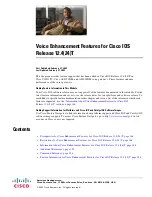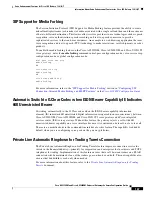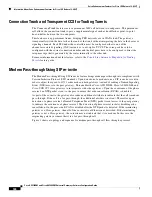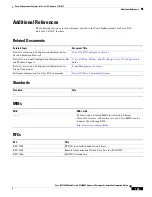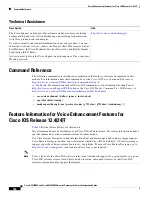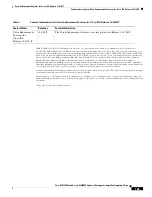
Configuring Voice over IP
Enabling QoS Features for VoIP
18
Cisco AS5350XM and Cisco AS5400XM Universal Gateways Software Configuration Guide
•
IP RTP Priority
, available online at
http://www.cisco.com/univercd/cc/td/doc/product/software/ios120/120newft/120t/120t5/iprtp.htm
•
Frame Relay IP RTP Priority
, available online at
http://www.cisco.com/univercd/cc/td/doc/product/software/ios120/120newft/120t/120t7/
friprtp.htm
Resource Reservation
You can set things up so that your and any other similarly-set-up sending or receiving system can reserve
bandwidth, on a call-by-call basis, along a router path by enabling RSVP (Resource Reservation
Protocol) on all WAN links that transport voice traffic.
Configure RSVP when you configure dial peers. Do not enable RSVP in conjunction with Frame Relay
traffic shaping.
Tip
For more information and configuration options, see
Voice over IP for the Cisco AS5300
, available online
at
http://www.cisco.com/univercd/cc/td/doc/product/software/ios120/120newft/120t/120t3/voip5300/
Call-Admission Control
You can gracefully prevent calls from entering your Cisco AS5350XM or Cisco AS5400XM universal
gateway from the PSTN when certain resources—such as CPU, memory, and interfaces—are not
available to process those calls. Such intervention is called call-admission control.
If your system experiences high CPU usage, large call volumes, or occasional large numbers of
simultaneous calls, you need to control two specific aspects of call-admission control: call spikes and
call thresholds. Doing so is especially important if you handle transactions involving debit cards, which
require AAA and similar types of support.
Configure call spikes to limit the number of incoming calls over a short period of time. Configure call
thresholds to define under which circumstances system resources should be enabled.
Tip
For more information and configuration options, including how to configure limits on call spikes and
call thresholds, refer to the following document:
•
Call Admission Control for H.323 VoIP Gateways
, available online at
http://www.cisco.com/univercd/cc/td/doc/product/software/ios122/122newft/122limit/122x/122xa/
122xa_2/ft_pfavb.htm
Fragmentation and Interleaving
Transmission of voice packets, usually small (60 to 240 bytes) in size, can be unduly delayed in networks
that also transmit large data packets. Fragmenting large data packets into smaller ones and interleaving
voice packets among the fragments reduces jitter and delay. Use fragmentation and interleaving in
conjunction with a congestion-management technique such as IP RTP Priority, RSVP, or both if you have




















